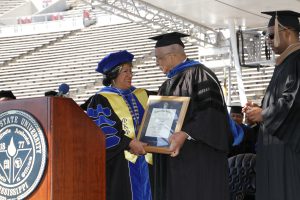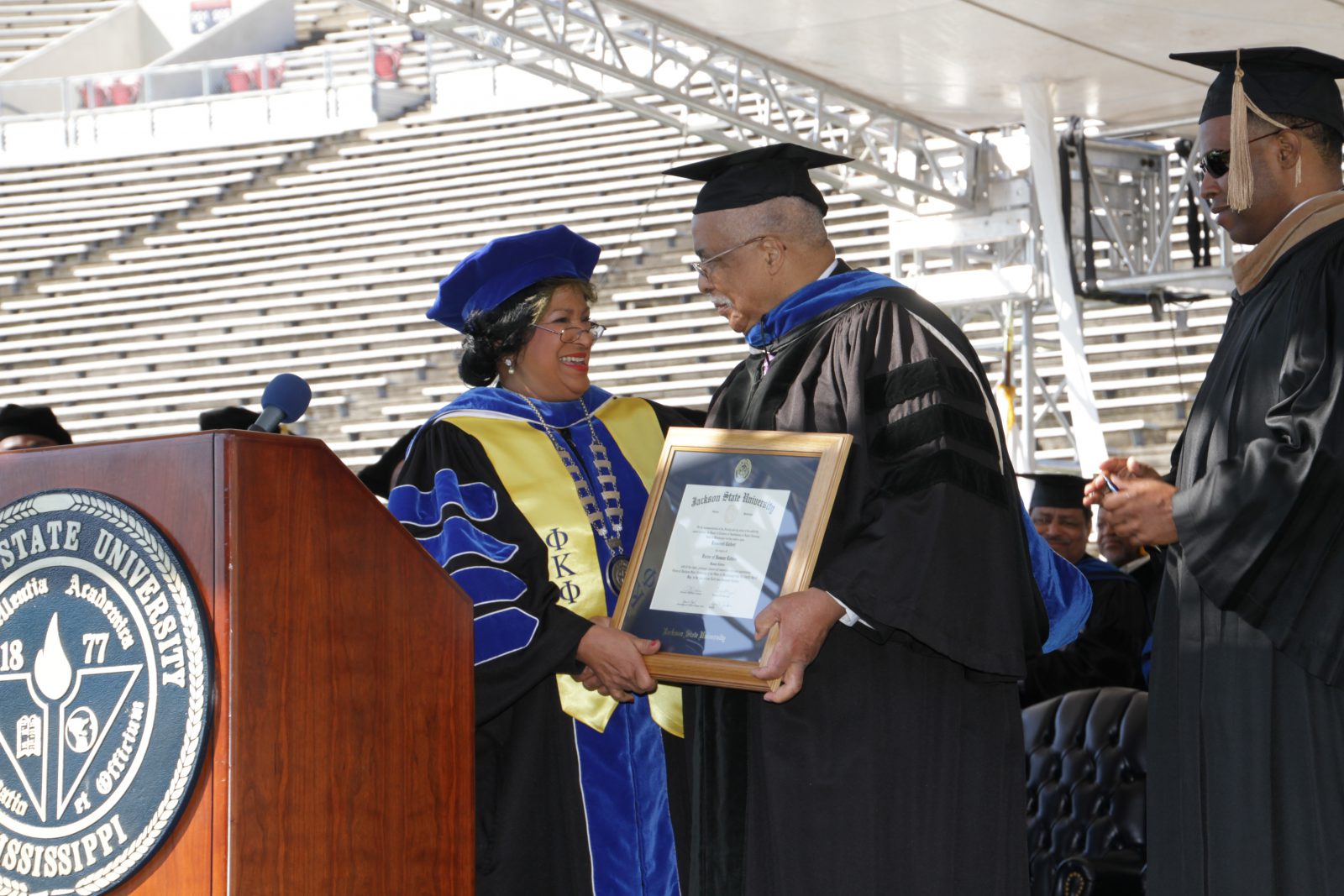 A half century after he left Jackson State University with a degree in science, Dr. Roosevelt Calbert recently returned to the campus to receive an honorary doctorate for devoting his career to improving educational opportunities for minorities.
A half century after he left Jackson State University with a degree in science, Dr. Roosevelt Calbert recently returned to the campus to receive an honorary doctorate for devoting his career to improving educational opportunities for minorities.
The 81-year-old Calbert has had a distinguished teaching and research career, including service as the director for the National Science Foundation, Division of the Human Resource Development. The division is responsible for broadening the participation of underrepresented groups in science and engineering.
“That’s been my life’s work. I feel I’ve made a difference,” Calbert said during an interview on Tuesday.
He said receiving the Doctorate of Humane Letters from JSU on May 4 was “exhilarating and heartwarming.” He also said he was proud to see the university’s progress.
“I’m impressed by the university’s growth. I’m impressed that you now have a president who fully understands the issues of higher education, particularly when it comes to STEM disciplines,” he said, referring to Dr. Carolyn W. Meyers, JSU’s president, who is also an engineer.
Calbert said he and Meyers worked briefly at the NSF. He’s been retired since 2000.
During the May 4 commencement ceremony, Meyers said Calbert worked to dispel perceptions that women and minorities couldn’t excel in science, technology, engineering and mathematics.
“He was starting his career at a time when everybody was spouting the rhetoric and false information that people of color and women could not excel in science and engineering and mathematics,” Meyers said. “There was no model and no pilot for what he did.
“Armed with his Jackson State University degree in physics, and a strong belief that any child given the opportunity can learn and excel and contribute to our science and mathematics enterprises in this country, he created a national model at the National Science Foundation in the 1970s.”
Calbert said Tuesday despite some early supporters of his efforts, he faced challenges.
“The key was getting people to listen to what you have to say. Lay out a model and see if they try to understand,” he said. “Whenever I would visit a HBCU, I would try to take someone who was non-minority from the other research programs so they could see what minority institutions had to offer. The college visitations were very critical,” he said.
Calbert received a Master of Arts for Teaching at the University of Michigan and a master’s and Ph.D. in plasma physics from the University of Kansas in 1969 and 1971, respectively.
He began his career with the NSF in 1975. He served in several significant positions throughout his tenure, including program director for the Research Improvement in Minority Institutions Program and the Minority Research Centers of Excellence Program; acting program director for the Research Careers for Minority Scholars Program and the Louis Stokes Alliances for Minority Participation Program.
Calbert also was senior program analyst in the Office of Planning and Resource Management; NSF representative to the White House Initiative on Historically Black Colleges and Universities; and a member of the NSF Affirmative Action Working Group.
Calbert became a valued expert in diversity and science policy and administration, as well as an expert on NSF and federal policies, procedures, rules and regulations. He was the recipient of the NSF Distinguished Service Award, the agency’s highest non-monetary honor. In 2007, Calbert was selected as an inductee to the Hall of Fame for Historically Black Colleges and Universities.
These days, Calbert said he’s enjoying his retirement. He’s active in church and he and his wife, Thelma, spend time traveling and visiting their children and grandchildren. He said he’s still willing to promote diversity in STEM disciplines.
“I don’t think my mission will ever end. I’m willing to work for anyone who’s willing to pursue it,” he said.








Leave a Reply